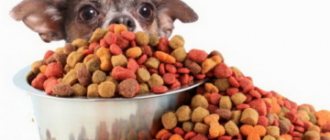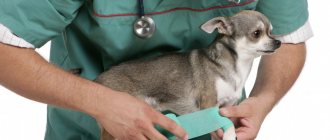If your family has decided to buy a Chihuahua, then the question certainly arises: what do they eat, what can and cannot be fed to the dog at home. The problem is that it is very difficult for a novice owner to make a decision, because he does not know what is better to choose, ready-made food or natural food. There are also hundreds of manufacturers of ready-made food on the market, and you run the risk of buying a low-quality product. In this article you will learn everything about the features of feeding a Chihuahua and learn how to do it correctly.
Unfortunately, when it comes to pet nutrition, people don't pay much attention to it. And all because many people do not know and have no idea about the importance of diet and its impact on the dog’s life. However, you cannot treat the issue of dog nutrition so frivolously!
Why do you need proper nutrition?
Proper nutrition is the key to health and longevity for any Chihuahua. After all, it affects the growth and development of both a puppy and the maintenance of the tone of an adult dog. Normal functioning of the digestive system, the body's resistance to infections, poisons and parasites, strong teeth, good gums, the formation of a strong musculoskeletal system and uninterrupted functioning of the central nervous system, strong muscles and joints - all this is impossible without specialized feeding.
The diet should be balanced. And food must contain all vitamins, minerals, micro and macroelements. Food at home is the main source of energy, this expresses the dog’s need for proteins, fats and carbohydrates.
Did you know the difference between the diet of humans and dogs? It lies in the fact that a person needs to eat fruits and vegetables to obtain vitamin C, and the dog’s body produces it itself.
Squirrels
Proteins are involved in the construction of tissues and cells, regulation and metabolism processes. These high-molecular compounds, built from 20 amino acid residues, play a primary role in the life of all organisms. The most protein is found in meat, fish, eggs, legumes and dairy products.
Carbohydrates
Carbohydrates are complex organic compounds consisting of sugars, starch and cellulose. Foods rich in carbohydrates include flour products, cereals, wheat, rice and vegetables. Fiber not only improves intestinal motility, but also slows down the absorption of sugar, so it can be included in the diet of dogs with diabetes. Excessive consumption can cause inability to absorb vitamins and minerals, flatulence and diarrhea. It is recommended to use corn, wheat and soy with caution; in addition to fiber, they contain allergens.
Fats
There has long been an opinion that fat is the main enemy of a healthy physical form, because its excess is deposited on organs, which leads to impaired metabolism and many diseases, including obesity. And this is true, but only large amounts of fat are harmful. But the body cannot do without an acceptable and obligatory dose of fat! It is a necessary component of proper nutrition. This is the most energy-intensive substance on which thermoregulation, the condition of the coat, as well as the normal functioning of the immune and nervous systems depend.
Vitamins and minerals
There are 2 types of vitamins - water-soluble and fat-soluble. Their deficiency leads to serious diseases, and an excess of one or the other leads to hypervitaminosis and hypovitaminosis - equally dangerous conditions. It is important to maintain a balance of these two types of vitamins. Minerals such as zinc and iron help prevent anemia and other disorders. And calcium and phosphorus are involved in the formation of the skeleton and teeth. It should be remembered that the body needs all the elements. But only in the right proportions. For example, an excess amount of phosphorus in the body is fraught with kidney problems.
Your dog should always have access to clean, fresh water!
The benefits and harms of cheese
In order to answer the question of whether it is possible to give a dog cheese, it is important to understand what its benefits and harms are for the animal’s body. Cheese, like any fermented milk product, is rich in nutrients and microelements. Therefore, in limited quantities it can be useful for a pet. But in some cases its use becomes undesirable. If the potential harm outweighs the intended benefit, then giving cheese to your pet is under no circumstances recommended.
Benefit
Many dogs cannot drink milk (due to the high lactose content) and therefore do not get all the nutrients it contains. This deficiency can be compensated to some extent by consuming fermented milk products.
The benefits of cheese for dogs are due to the high content of easily digestible protein. The concentration of microelements and vitamins in it is several times higher than in milk. Of the entire list of microelements, the main share belongs to calcium and phosphorus (animals are very acutely deficient in these microelements). Cheese contains slightly less other microelements: zinc, iodine, selenium, iron, copper, potassium. It is also rich in vitamins (A, B1, B2, B12, C, D), as well as nicotinic acid.
Proteins are building materials for body tissues; they take part in the synthesis of hormones and the formation of protective forces. B vitamins ensure the normal functioning of the hematopoietic system and nervous system.
Harm
Let's look at why dogs should not consume this product in unlimited quantities. The main harm to the dog’s body comes from the high content of milk fats and salt. In addition, some types of cheese contain lactose, to which some individuals are intolerant.
Cheese is a strong allergen, so it should not be given to individuals with an allergic body.
If you consume a low-quality product, there is a high risk of food poisoning. Why buy cheese in supermarkets? Sliced cheese neatly laid out on the counter is rarely fresh. Sometimes a cheese product is sold under its guise.
Newborn puppies
There are cases when, for some reason, a nursing bitch cannot provide her cubs with milk, then the mother’s milk is replaced with cow’s or goat’s. The first feeding of the puppy is carried out from three weeks. If this is ready-made food, then it is served only in soaked form. To do this, take a few granules of dry food, pour boiling water over it, leave for 20-30 minutes, and then give the puppies 1 granule.
A few pieces per day will be enough, gradually increasing the amount every day. In the first months they begin to include natural food. It is required to serve boiled meat and cottage cheese (diluted in milk to a more uniform consistency). Food is liquid and soft; dry food in an unsoaked form is strictly prohibited, because the stomach and intestines are not yet ready to digest solid food. From one month of age - rice, buckwheat, oatmeal with water or milk.
Features of feeding Chihuahuas with ready-made food
So, feeding your Chihuahua properly with natural food is not easy. You will need to choose certain foods (for example, you should not give your Chihuahua certain types of meat), stand at the stove, and count the amount of nutrients. Then you can choose ready-made food as an alternative to “natural” food. Let's look at what the concept of “best food for Chihuahuas” means. So, in order not to harm your small pet, you will need to consider the following:
Photo: Dog food | Dreamstime.com
- For Chihuahuas, wet or dry food labeled “for small (or toy) breeds” is suitable. For example, Royal Canin Size Mini food. Foods for large dogs have more calories than what a Chihuahua needs;
- Wet and dry food for Chihuahua dogs should be extra premium or premium quality (for example, Grandorf or Acana). Cheap economy food, unfortunately, does not have anything particularly good in its composition. They contain soy, vegetables of dubious quality, a minimum of meat, meat waste, flavor enhancers, and dyes. And good food contains meat, grains, vegetables, herbs, eggs, that is, those products that a Chihuahua requires;
- Most good products are divided into foods for babies, adults and old Chihuahuas. A baby Chihuahua has one need for vitamins and healthy components, but an older Chihuahua has a completely different need;
- Food for Chihuahuas should be purchased taking into account the characteristics of the dog. Let's say Barking Heads food for small breeds with sensitive digestion.
In addition to dry food for your Chihuahua, you can buy good quality canned wet food. They can be alternated with dry products, but you should not combine food in one bowl. The disadvantage of canned dog food is that it spoils quickly after opening. Whereas dry food is stored for a long time.
As you grow older
Puppies feed on their mother's milk until they are approximately 2 months old. But sometimes up to 4 months. It is recommended to completely wean offspring from mother's milk at 3-4 months. Further feeding of the Chihuahua depends on your choice and the dog’s taste preferences. There are 2 ways of feeding: natural and ready-made food.
There are dogs that can consume both types, and there are individuals for whom one type is suitable: either natural or prepared food. Some people experience diarrhea, diarrhea, and stomach problems from natural food, while others have a similar reaction to ready-made food. Just watch your four-legged friend. See what he likes to eat more. Does the food cause intestinal upsets and digestive problems? If yes, then this is a signal that the chosen feeding method is not suitable for you and needs to be replaced.
Do not mix natural and commercial food!
Natural or dry food, which is better?
There is no clear answer. Each of them has its own pros and cons . Many people beat themselves in the chest, claiming that “natural” is better, since the owner independently monitors what goes into his dog’s body, and these products contain all the necessary substances, minerals and vitamins. However, they are mistaken, because quite often such nutrition is not balanced, and it remains very difficult for a person to choose the right proportions. At a time when everything is already calculated in the package of dry food.
Ready food
It is divided into dry (pellets) and wet (canned). Today, stores stock a whole range of products from various manufacturers. This or that brand is advertised on television. To choose high-quality food, do not believe advertising, but purchase only premium and super-premium food. These include Acana, Hills, Pro Plan, Orijen, Royal Canin, Eukanuba. In this case, price is an indicator of quality; the higher, the better the product.
pros
- Balance.
- Convenient travel.
- Easy to use.
- Quick cooking.
- Dosage.
- Convenient storage.
Minuses
Possibility of containing harmful additives: preservatives, dyes, flavorings and flavor enhancers.
Check the expiration date carefully and do not feed your Chihuahua an expired product.
Looking at the label
Study the composition. Avoid feeds where the main ingredient is an animal by-product. If “offal” is indicated, it means bones, skin, legs and beaks were used. Basics like these can be subcategorized and printed at the back of the package (with the hope that inattentive shoppers won't notice).
Of course, preservatives are harmful and have a very bad effect on the health of the Chihuahua. All packaged foods inevitably contain them. The safest of them are tocopherols, which are made on a vitamin basis. Such feeds have a shorter shelf life. Synthetic preservatives - BHA, BNT, ethoxyquin cause tumor formation in the stomach of rats, hamsters and mice. If the consumer needs the manufacturer, the telephone number, name and address of the distributor must be printed on the label. Sometimes they even print the email address and website on the Internet.
Don't feed your Chihuahua cat food!
Natural food
If you decide on this diet, then monitor the quality and freshness of the products you purchase. Cooked porridge or other dishes should be at room temperature; do not give your dog hot food so that it does not get burned.
Advantages
- No harmful additives.
- The owner himself chooses the quality and monitors the freshness of the products.
- Contains all micro and macroelements, vitamins and minerals, amino acids.
Flaws
- Cooking requires a huge amount of time.
- Not balanced.
- Difficulty in storage.
Is it possible to give dogs cheese?
Most pets try food from the owner's table and cheese becomes a frequent treat. It contains useful trace elements and minerals. Dog trainers use small pieces of the product to reward pets. However, veterinarians do not recommend this type of treat. To answer the question, “can you give your dog cheese?”, you need to weigh the potential benefits and harms.
Product benefits
Fermented milk products are an essential part of a dog’s natural diet. Milk is not tolerated by adult animals, since lactose is not digested by them, causing indigestion.
Fermented milk products can compensate for the lack of beneficial microelements contained in milk. In particular, cheese contains:
- Vitamins B, D, retinol are responsible for the condition of hair and skin.
- Ascorbic and nicotinic acid, involved in most metabolic processes.
- Phosphorus and calcium are essential for bone health.
- Magnesium and zinc, which affect the state of the nervous system.
- Iron and copper, necessary for complete hematopoiesis.
- Proteins are the “building material” for muscle tissue.
The dog gets similar microelements from meat, but with a monotonous diet they become insufficient. A pet, just like a person, gets tired of eating the same thing.
There is an opinion that if a dog asks for a fermented milk product, he is experiencing a calcium deficiency and tries to replenish it on an intuitive level. This scenario is possible, but more often animals simply like the taste. If your pet shows an increased interest in all the “milk,” get him tested before revising his diet.
Harm
Along with the usefulness of cheese, its unlimited consumption will cause health problems. Vitamins and minerals are part of the product, milk fats and protein occupy a large share. Their excess overloads the dog’s digestive system, the liver does not have time to break them down, the pancreas cannot cope with the load, and diarrhea, bloating, and loss of appetite occur.
A large amount of salt in the composition leads to its accumulation in the body. The product also causes hypersensitivity, so it can lead to skin irritation and itching. The situation is aggravated by chemical additives in the composition: preservatives, flavorings and taste enhancers.
Natural treats may be difficult for dogs who eat commercial food to digest.
How to protect yourself from obesity?
This issue should be taken very seriously when caring for your animal. Chihuahua is a breed with a tendency to be overweight. To prevent the occurrence of this disease, follow the general rules.
- These dogs love to eat, and some of them cannot control their satiety. Free access to food is unacceptable.
- Feeding is carried out strictly according to the clock. To avoid malnutrition and oversaturation, do not break the schedule and stick to the established regime.
- Do not feed your dog from the communal table.
Older dogs are more likely to suffer from obesity, and this is quite natural, since many physiological changes occur at this time. Older dogs are less active and their metabolic rate is significantly reduced. It is very sad when obesity appears in young dogs due to overeating and mistakes of their owners.
Most owners do not realize that obesity entails a whole list of concomitant diseases: arthritis, tracheal collapse, inflammation of the ligaments and tenosynovitis, diabetes, diseases of the gastrointestinal tract, heart and kidneys, musculoskeletal system, respiratory tract and dislocations of the kneecaps. These diseases pose a great threat to such a small and fragile dog breed.
Reception frequency
This miniature breed has its own peculiarity - the process of growing up in a Chihuahua differs from its “large brothers”. A dog that reaches 8 months is considered an adult, and at this stage its growth stops.
Chart by age
- From 3 weeks to 2 months - 6 times a day
- From 2 to 6 months - 4 times a day.
- From 6 to 12 months - 3 times a day.
- From 1 year and older - 2 times a day.
- Dogs over 7 years old should be fed once a day.
Quantity
For dosage when feeding dry food, see the packaging. Small puppies start feeding with 1 granule. For one-month-old puppies, the measure will be about 1 - 2 teaspoons of dry or natural food. At 2 months, approximately 1 tablespoon is considered normal. As you grow older, the amount of food will increase, gradually reaching 1.5 - 2 tablespoons. The maximum dose for an adult is 1.5 - 2 tablespoons of food.
Portions and frequency
Miniature dogs should be given no more than 1 tsp. no more than 2 times every 14 days. Large animals - up to 6 tbsp. l. three times a week. Give daily (or every other day) to aging dogs and those who are prone to periodic constipation.
Pregnant or nursing
They need to be given a lactic acid drink, this is a real storehouse of nutrients for pregnant/lactating females. For comparison: 100 grams of raw meat contains 18-25 grams. Protein, about the same amount in 0.5 liters of kefir. Give as a separate product, or mix with cottage cheese, chicken egg (raw).
You can give an unlimited amount per day, but be sure to monitor the body’s reaction. If the female develops a gag reflex, loose stools, or attacks of nausea, exclude it for a while. Then add in minimal dosage to porridge. It is important to know that lactating females consume more food than others.
For puppies
Start feeding kefir when the kitten is 1-2 months old. Acceptable dosage = 1-2 tsp. three times a week. As the puppy grows, gradually increase the volume of the lactic acid drink. The main condition is to choose a product with a low fat content. The optimal option is 1-2%, since gastrointestinal tract disorders are possible: loose stools, vomiting, nausea.
List of useful products
Meat
Beef, turkey, rabbit, veal, and horse meat are excellent as the main source of protein. Served in chopped boiled form, give preference to lean pieces. Experienced breeders strongly recommend excluding chicken. The risk of infection with growth hormones and antibiotics is too high.
By-products
When it is not possible to cook meat, offal is an excellent alternative. For variety, you can pamper your pet with beef innards: heart, stomach, kidneys, liver, lung, tongue, tripe, udder. It is forbidden to feed raw meat and offal to avoid infection with worms and parasites.
Fish
You should avoid river food, and sea food should be prepared no more than 1-2 times a week. Use low-fat varieties (limonella, cod, trout). The benefits of fish are undeniable, because it is a source of omega 3,6,9 fatty acids. Only it contains the required daily dose of most amino acids, such as glutamine, arginine, leucine, lysine, proline, cystine, alanine, glycine, isoleucine, threonine, valine. Fish also contains tryptophan, which has a beneficial effect on healthy sleep quality. The full composition of B vitamins perfectly supports the functioning of the central nervous system, calms, improves memory and concentration, maintains a good mood, prevents the development of depression, and has a positive effect on brain function.
The content of other vitamins and minerals (A, E, D, K,PP, C) and minerals (calcium, magnesium, sodium, potassium, phosphorus, manganese, selenium, iron, copper, zinc) helps stabilize blood cholesterol levels (bad cholesterol is displayed). Helps in improving the condition of the musculoskeletal system, skin, establishing metabolic processes, maintaining visual function of the eyes, healing and strengthening the cardiovascular system, removing heavy metals and toxins, bringing water balance back to normal, increasing the body's protective functions and strengthening the immune system. Its protein is easily digestible and does not burden the gastrointestinal tract.
Clinical studies from Harvard University have shown that consuming this product significantly reduces the risk of premature death from heart attack and stroke. It should be noted that owners of long-haired representatives will rejoice in the beautiful and shiny coat of their pets, acquired through the use of fish in the diet. It is very important to prepare the product correctly - you cannot fry or smoke it; fish is served only boiled or steamed. Carefully remove the fillet from the bones.
Dairy
Low-fat cottage cheese, kefir, milk, unleavened cheeses.
Cereals
Not all types are suitable, but acceptable - oatmeal, millet, rolled oats, egg, buckwheat, rice. Barley and semolina are practically not digestible and can cause intestinal volvulus. Buckwheat porridge remains the best option.
Vegetables
Boiled or with the addition of vegetable oil, carrots, cabbage, beets, pumpkin, zucchini, cucumber, tomato.
Eggs
No more than 1 - 2 times a week. 1 chicken or 2 quail eggs.
Fruits
Chihuahuas are one of the few breeds that love to eat apples, pears, bananas and tangerines.
Berries
Berries are a real storehouse of vitamins. And not only in the summer. Chihuahuas do not tolerate cold well; in winter they often catch colds, including from a lack of vitamins. To pamper your dog all year round and support its immunity, freeze cranberries, raspberries, strawberries, wild strawberries, blueberries, and currants in advance for the winter.
Recommended and prohibited foods for the Chihuahua breed
What do Chihuahuas eat? Before we talk about permitted and prohibited foods for Chihuahuas, it is necessary to mention some rules for feeding Chihuahuas with natural products:
- Food must be fresh. It is not recommended to cook several days in advance, but if you do, store the food in the refrigerator.
- The food should be at room temperature.
- The amount of food should always be the same. If the dog has not eaten enough, the bowl must be removed until the next meal.
- If a dog refuses some type of food, you should not indulge its whims. She didn’t eat at the first feeding, but will eat at the second when she gets hungry.
Now let's talk about what you can feed your Chihuahua dog:
- Meat. Any lean meat will do; it is recommended to give it daily. Twice a week can be replaced with boiled fish or liver (kidneys). It is recommended to boil chicken meat to avoid infection with salmonellosis; other types of product can be given raw.
- From cereals you can give millet, rice and buckwheat. In this case, the porridge should be well boiled.
- Fermented milk products: low-fat cottage cheese, homemade cheese, fermented baked milk, bio-yogurt, kefir. Giving milk to dogs is prohibited; it can lead to intestinal upset. You can give fermented milk products along with cereals.
- Vegetables. They are served stewed or boiled. You can also give raw vegetables (especially carrots), but first grate them and add vegetable oil or sour cream.
- Fruits are always given only fresh. They can be cut into small pieces or grated. Apples and bananas are very healthy.
- Eggs. It is recommended to give boiled or in the form of an omelet, but not more than once a week.
Special control should be taken regarding the absence of harmful foods , which include:
- Pork. It is too fatty, and when digested it puts a lot of stress on the liver.
- Sausages. Such products contain too many additives that are harmful to the dog’s body.
- Legumes. Lead to bloating and intestinal cramps. For the same reason, it is forbidden to give fresh cabbage; only sauerkraut is allowed.
- Sweets. Lead to tooth decay, indigestion and tearing.
How to create a diet?
To ensure a complete and balanced diet, follow the percentage ratio: 36% of all food is meat.
- 16% of all food is dairy products.
- 10% of all food is fish.
- 14% of all food is cereals.
- 15% of all food is vegetables.
- 9% of all food is fruit.
Sample daily menu for an adult dog
- Breakfast. 8.00 - 10.00. Boiled meat (or offal) or steamed trout with zucchini.
- Dinner. 15.00 - 16.00. Kefir, cottage cheese or 2 quail eggs.
- Dinner. 19.00 - 20.00. Buckwheat porridge with carrots, half an apple.
Make sure that your four-legged friend's diet alternates protein foods (fish, meat, eggs, cheese) with cereals, vegetables and fruits every day. So, for example, when choosing meat for the morning, you should provide your dog with vegetables, fruits and grains for lunch and dinner. The next day, choose fish with vegetables for breakfast, and for lunch and dinner, give dairy products, fruits, and porridge. Remember, fruits and vegetables, cereals should be included in every day, and meat, fish and dairy products are the basis of nutrition. Cereals are carbohydrates; too frequent consumption can lead to metabolic disorders.
Can a dog have kefir? – Benefits of the product
Many dog owners may say that kefir is not a basic product that an animal cannot do without, like, for example, meat. And indeed, to some extent they are right, since fermented milk products are extremely rare in nature. And the dog can easily do without them.
But there is a flip side to the coin.
Firstly,
We love our pet and want his diet to have enough of all microelements, including proteins. This problem is often solved with the help of elite varieties of dog food, but not all of us can afford to purchase it. And there is no particular need for this, if you can add kefir to your dog’s diet - it is both cheaper and safer in terms of poisoning from counterfeits.
Secondly, kefir:
- Improves and normalizes the functioning of the gastrointestinal tract in the presence of abnormalities.
- Adds shine to the coat and health to the skin.
- Normalizes microflora, eliminates dysbacteriosis.
- Increases the body's immune resistance to viral attacks.
And one more extremely important and, of course, fundamental aspect in the question of whether kefir is allowed for dogs. The fact is that this fermented milk product is not enriched with vitamin D, which is necessary for the high-quality absorption of calcium. As a result, most of it is eliminated from the body in an understandable way. What is this match for? You should not count on the fact that kefir can replace all sources of calcium, and especially meat.
Food for a pregnant bitch
The nutrition of pregnant and nursing mothers should be special. All basic products remain at your disposal, you just need to arrange them in a new way. If the pet eats store-bought food, then meat and egg yolks are added to it. If he eats natural food, then the first month after mating there is no need to change anything. After 4 weeks, the bitch’s need for proteins, vitamins A, D, E, B1, fish oil and folic acid increases. Hence :
- The share of meat is increasing - 60 - 65% of all food.
- From the 5th week of pregnancy, the bitch eats 3-4 times a day.
- Vegetables are preserved in the same quantity.
- A week before giving birth, calcium-rich and protein-containing foods are removed (to avoid eclampsia).
How much cheese should I give my dog?
Cheese should not be given systematically and daily. Dogs should only eat cheese in small quantities. It is used as a treat and reward for learned commands and well-done training. It should be perceived by the animal as a treat, and not as a given.
Before you treat your dog, the cheese must be prepared: cut into small pieces (20-100 g - depending on the weight and breed of the pet) and dried for 3-4 hours. You can give no more than 2 pieces.
IMPORTANT! Is it possible to give cheese to small puppies? It is strictly forbidden to feed it to puppies under one year of age. Until this moment, the animal’s gastrointestinal tract has not yet been formed, and the dog will not be able to digest the product without harm to health. Find out what you can feed a one-month-old puppy? Also, cheese is not recommended for pregnant and lactating pets.
Nutrition for a nursing bitch
In the first week after giving birth, a pregnant mother is given tea with milk and honey to enhance lactation. Feeding, as before, is carried out 4 - 5 times a day. Dried apricots and prunes are especially useful during this period. After weaning the puppies, the diet is slowly reduced and returned to the usual amount of food.
Prohibited Products
Please pay special attention that these foods should not be given to Chihuahuas! For them it is poison!
- Carbonated drinks.
- Alcohol.
- Caffeine.
- Hop.
- Pork.
- Sausage.
- Canned food.
- Tubular bones.
- Legumes.
- Plum pits.
- Apricot kernels.
- Peach pits.
- Walnut.
- Nutmeg.
- Macadamia.
- Avocado.
- Raisin.
- Grape.
- Pepper.
- Sugar, any sweets, candies, chocolate.
- Salt, salty.
- Spicy.
- Smoked.
- Roast.
- Pickled.
- Puddings, cakes, baked desserts.
- Mushrooms.
- Condiments, herbs, spices, mustard.
- Onions, onion powder.
- Potato tops.
- Rhubarb leaves.
- Tomato tops.
- Yeast mixture, flour, cookies, buns, bread.
- Pasta.
- Ice cream.











